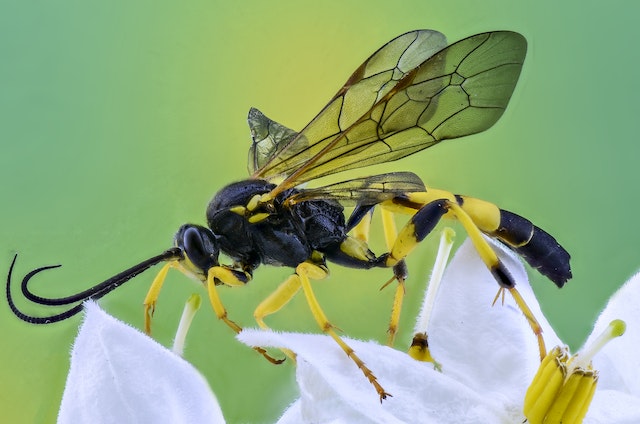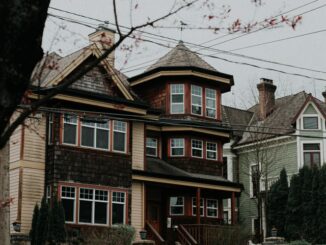
Wasps can become a problem if they are left alone to build their nest and settle in. Canada has over 500 species of wasps, most of which live in colonies that contain anywhere from half a dozen to 15,000 members each. The typical pest wasps are yellow jackets, hornets, paper wasps and mud daubers. A wasp nest can become a serious problem if nothing is done in the early stages of the development of the nest.
Identifying Wasps
Unlike some common species of bees, wasps have no hair on their body. Instead, wasps have three distinct body parts: the head, the thorax and the abdomen. The thorax is connected to the abdomen by a contracted petiole which gives it the appearance of a slim waist. The thorax has three pairs of legs attached to it and two pairs of membranous wings the wasp uses for flying. Like most other insects, the head of the wasp contains sensory organs like the eyes and the segmented antennae. Finally, the abdomen in female wasps contains egg-laying ovipositors.
The size of the wasp’s body and its color varies depending on the species. For example, Hornets and yellow jackets have colorful bodies with yellow, black and white markings on their bodies and faces. On the other hand, paper wasps are relatively long and thin-bodied with long legs and have distinctive yellow and black markings. Mud daubers are also distinct looking, with slender and long bodies and stalked abdomens.
Signs of a wasp infestation
A wasp nest can be found in various areas in or around homes. For example, paper wasps tend to build aerial nests that hang from tree branches, the eaves of roofs or even from home decks or playground equipment. Yellow jacket nests are typically built on the ground, using older rodent burrows or protected areas beneath rock piles and shrubs. It’s essential to identify the type of wasp before you can go about correctly removing the wasp nest.
Issues with dealing with wasp nests
Wasps are an aggressive type of pest, and they will sting anyone who attempts to take down their nests. People who have allergies to wasp venom are at risk of having a severe reaction if they get stung. This makes it essential to take the following basic steps to avoid getting stung by wasps:
– Keep all food covered at all times
– Make sure that all garbage lids are tightly sealed
– Keep an eye out around homes and yards for places where wasps might begin to live and catch any nests early on as they are starting to be built.
How to proactively prevent wasps from becoming an infestation
Some common methods to combat a wasp infestation include sealing all points of entry into your home. This includes sealing up and fixing any cracks around your windows and doors as well as repairing any damage that has been done to your door and window screens. Another method to prevent a wasp infestation is to remove or reduce the available food sources that wasps can take nourishment from. Any food that is kept outside the fridge should be sealed up and any and all spills and crumbs should always be cleaned up right away. Keep all of your trash in a trash bin with tight fitted covers, and also make sure to keep all garbage bins at some distance from your house. You can remove the possible nesting sites for wasps by trimming back vegetation and bushes as well as removing old and unused wasp nests.
Wasp Habitats
Wasp nests can vary in shape, size and location depending on the type of wasp species. Paper wasp nests are made up of paper-like material, which they obtain by chewing and gluing plant material together. These nests are single-layered and comb-like, with no easily definable enclosure and typically consist of 150 to 300 cells each. These nests are stalked, which means that they are attached to an object by means of a long stalk or stem known as a pedicel. Paper wasp nests are typically attached to objects such as tree branches, fences, shrubs, eaves, window frames and exterior joints.
Yellow jackets and hornets make their nests out of plant materials as well, however, these nests are multi-layered and consist of five to nine combs which make up a total of 1500 to 3500 cells each. Their nests can be exposed or protected by a paper envelope. Some yellow jacket nests can be the size of a football. These nests are typically found in locations such as inside hollow trees, spaces within walls, structures such as garages, attics and sheds, and bushes and trees. Some hornets and yellow jackets can build their nests in the ground, typically in areas that don’t have any other vegetation.
Wasp Extermination
If you come across a wasp nest on your property, don’t be adventurous, call a professional, Bumble bees and honeybees are protected species in Canada. Therefore, it is important that a licensed company like Vanquish Pest Control www.vanquishpestcontrol.com is called for the job. Their trained exterminators will identify the type of wasps and safely remove it.















